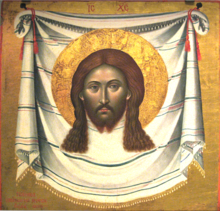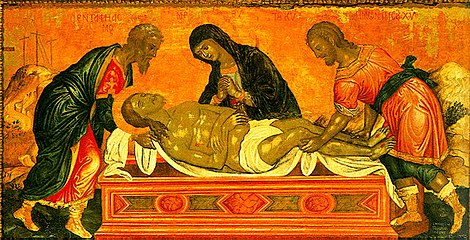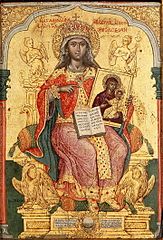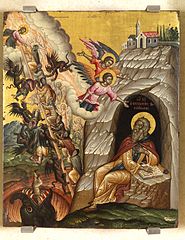| Emmanuel Tzanes | |
|---|---|
 The Holy Towel The Holy Towel | |
| Born | 1610 Rethymno Crete |
| Died | March 28, 1690 Venice |
| Nationality | Greek |
| Movement | Cretan School, Heptanese School |
Emmanuel Tzanes (Greek: Εμμανουήλ Τζάνες; 1610 – 28 March 1690), also known as Bounialis (Greek: Μπουνιαλής) Emmanuel Tzane-Bounialis, Emmanuel Zane, and Emmanuel Tzane, was a Greek Renaissance iconographer, author, clergyman, and educator. He spent the latter half of his life in Venice, where he was parish priest of the church of San Giorgio dei Greci and a member of the Flanginian School run by the city's Greek Confraternity. Tzanes wrote icons in the style of the Cretan School, influenced by contemporary trends in Venetian painting. His known extant works, over 130 in number, can be found in public foundations, private collections, churches and monasteries in Greece. The most popular of these is The Holy Towel, finished in 1659. Tzanes was a collaborator with Philotheos Skoufos, and brothers with the painter Konstantinos Tzanes and the poet Marinos Tzanes.
History
Born in Rethymno, Crete, Tzanes became a priest sometime before 1637. After the Ottomans conquered Rethymno in 1646, he fled Crete and spent eight years in Corfu. Here he wrote numerous icons, sometimes in collaboration with Philotheos Skoufos. Tzanes moved to Venice in early 1655, remaining there for the rest of his life. In March of that year he applied to become the priest of San Giorgio dei Greci, offering to paint the church for free, but was initially turned down in favor of Skoufos. Skoufos vacated the position in 1660 and was succeeded by Tzanes, who served for the next twenty years. During his tenure he conducted twenty-six marriages. He was also the supervisor at the Flanginian School of the Greek Confraternity in Venice.
Over one hundred and thirty paintings by Tzanes survive, dating between 1636 and 1689. He served both Catholic and Greek Orthodox clients and produced works of all sizes, from small icons and triptychs to monumental paintings and sanctuary doors. Adhering to the Cretan School style which he learned in Rethymno, his paintings are dated and often include clients' portraits. His influence can be seen in works of the later Heptanese school. Tzanes regularly wrote icons of Saint Alypius the Stylite, Saint Gabdelas the Persian, Saint Demetrius on horseback, and the Virgin and Christ enthroned. His brother Konstantinos Tzanes was also a painter and lived in Venice with him.
Gallery
-
 Christ Enthroned
Christ Enthroned
-
 Jesus Christ
Jesus Christ
-
 Virgin and Child
Virgin and Child
-
 Virgin and Child
Virgin and Child
-
 Lamentation
Lamentation
-
 Lamentation of Christ
Lamentation of Christ
-
 Miracle of Cincture
Miracle of Cincture
-
 John the Baptist
John the Baptist
-
 St. Mark the Evangelist
St. Mark the Evangelist
-
 St. George killing the dragon
St. George killing the dragon
-
 Saint Nicholas of Myra
Saint Nicholas of Myra
-
Saint Cyril of Alexandria
-
 Saint Theodora
Saint Theodora
-
 Saint Gobdelas the Persian
Saint Gobdelas the Persian
-
 Ladder of Divine Ascent
Ladder of Divine Ascent
Timeline of artistic works
Crete
- 1636 Saint Spyridon (Correr Museum, Venice)
- 1640 Evangelism (Berlin State Museums)
- 1641 Theotokos Amolintos (Madonna and Child) (Museum of Zakynthos)
- 1644 The Tree of Jesse (Hellenic Institute of Venice)
- 1645 Theotokos Odigitria (Madonna and Child) (Holy Trinity Giudecca, Venice)
- 1645 Agios Antonios (Panagia ton Xenon, Corfu)
- 1646 Timios Prodromos (John the Baptist) (Church of Timios Prodromos, Kranidi)
Corfu
- 1648 Christ in Glory (Metropolitan Palace, Corfu)
- 1648 Saint Cyril (Byzantine and Christian Museum, Athens)
- 1649 Agios Iason (Church of Saints Jason and Sosipatros, Corfu)
- 1650 Agios Sosipater (Church of Saints Jason and Sosipatros, Corfu)
- 1650 Theotokos Enthroned (Church of Saints Jason and Sosipatros, Corfu)
- 1651 Theotokos (Virgin) Madre della Consolazione (Monastery of Platytera, Corfu)
- 1654 Saint Cyril of Alexandria (Museum of Antivouniotissa)
- 1654 Agios (Saint) Ioannis o Damaskinos (Church of Saints Jason and Sosipatros, Corfu)
- 1654 Saint Gregory of Palamas (Church of Saints Jason and Sosipatros, Corfu)
- 1655 Agios (Saint) Gavdelaas (Private Collection, Venice)
Venice
- 1656 Agios (Saint) Dimitrios (Loverdos Collection)
- 1657 Do not touch me (Antivouniotissa, Corfu)
- 1657 The Virgin Mary Madre della Consolazionne
- 1657 Saint Mark (Tzanes)
- 1662 Saint Onuphrius (Tzanes)
- 1663 Ladder of Divine Ascent (Tzanes)
- 1664 Christ Enthroned (Tzanes)
- 1671 Saint Theodora (Tzanes)
- 1684 Lady the Lambovitissa
Literary works
- Satisfaction is beneficial for every Christian (In Greek)
- Sequence of the holy great martyr Fotini of Samaritan, or Christ spoke in the well (In Greek)
- Narration with lyrics of the terrible war that took place on the island of Crete (In Greek)
See also
References
- Speake, Graham (2021). Emmanuel Tzanes Encyclopedia of Greece and the Hellenic Tradition. London And New York: Rutledge Taylor & Francis Group. p. 443. ISBN 9781135942137.
- Heinz Skrobucha, The World of Icons, 1971, p.97
- Jane Turner, The Dictionary of Art, 1996, p.334
- Steven Bigham, Heroes of the Icon: People, Places, Events, 2000, p.136
- Tsokkoy, Κ. Α. (2008). Aristotle University of Thessaloniki Philosophical School Refugees of the Cretan War (PDF). Thessaloniki, Greece: Aristotle University of Thessaloniki. pp. 87–88.
- Tsokkoy, 2008, p. 158
- Speake, 2021, p. 443-447
- "Icon of Saint Govdelaas -". MBP. Retrieved 2024-12-01.
- Eugenia Drakopoulou (May 25, 2021). "' Tzanes (Zane) Konstantinos (Constantino)". Institute for Neohellenic Research. Retrieved May 25, 2021.
- Speake, 2021, p. 444-445
Bibliography
- Tselenti-Papadopoulou, Niki G. (2002). Οι Εικονες της Ελληνικης Αδελφοτητας της Βενετιας απο το 16ο εως το Πρωτο Μισο του 20ου Αιωνα: Αρχειακη Τεκμηριωση [The Icons of the Greek Brotherhood of Venice from 1600 to First Half of the 20th Century]. Athens: Ministry of Culture Publication of the Archaeological Bulletin No. 81. ISBN 960-214-221-9.
- Hatzidakis, Manolis; Drakopoulou, Evgenia (1997). Έλληνες Ζωγράφοι μετά την Άλωση (1450-1830). Τόμος 2: Καβαλλάρος - Ψαθόπουλος [Greek Painters after the Fall of Constantinople (1450-1830). Volume 2: Kavallaros - Psathopoulos]. Athens: Center for Modern Greek Studies, National Research Foundation. hdl:10442/14088. ISBN 960-7916-00-X.
| Late Cretan Renaissance | |
|---|---|
| Principal proponents | |
| Other artists | |
| Major works |
|
| Related | |
| Emmanuel Tzanes | |
|---|---|
| Paintings |
|
| Churchs | |
| Siblings | |
| Related | |